Adelaide city centre
Adelaide city centre is the inner city locality of Greater Adelaide, the capital city of South Australia. It is known by locals simply as "The City" or "Town" to distinguish it from Greater Adelaide and from the City of Adelaide local government area (which also includes North Adelaide and the Park Lands around the whole city centre). Due to the construction of many new apartments in the city, the population has grown over ten years from 10,229 (2006 census) to 15,115 (2016 census).
| Adelaide Adelaide, South Australia | |||||||||||||||
|---|---|---|---|---|---|---|---|---|---|---|---|---|---|---|---|
 Aerial view of part of the Adelaide city centre at night, 2014. | |||||||||||||||
| Population |
| ||||||||||||||
| • Density | 1,440/km2 (3,728/sq mi) | ||||||||||||||
| Established | 1837 | ||||||||||||||
| Postcode(s) | 5000 | ||||||||||||||
| Area | 10.5 km2 (4.1 sq mi) | ||||||||||||||
| Location |
| ||||||||||||||
| Region | Eastern Adelaide[3] | ||||||||||||||
| State electorate(s) | Adelaide | ||||||||||||||
| Federal Division(s) | Adelaide | ||||||||||||||
| |||||||||||||||
Adelaide was planned based on a grid layout featuring streets that run at right angles to each other, surrounded by gardens and parks. Within the city centre, there are other designations used to describe various areas, the broadest being:
- The city "square mile", bordered by North, East, South and West Terraces, part of which is referred to as the CBD (most of the northern half), as well a mixture of high-rise apartments and various commercial and entertainment premises scattered throughout, and the smaller cottage residences (mostly in the southern half).
- Within the "square mile", there are also defined precincts such as the West End and the East End with distinctive characters.
- The section of the parklands between North Terrace up to the River Torrens, which includes the string of medical, educational, cultural and entertainment institutions on the northern side of North Terrace, notably the Adelaide Festival Centre as well as the Parliament of South Australia and Adelaide Railway Station. Part of this area is sometimes referred to as the North Terrace cultural precinct.
Other well-known institutions within the city centre are the Adelaide Central Market, Victoria Square and Rundle Mall shopping area.
History
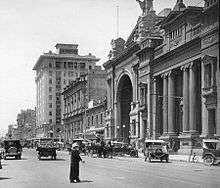
Before the British colonisation of South Australia, the Adelaide Plains, on which Adelaide was built, were home to the Kaurna group of Aboriginal Australians. The colony of South Australia was established in 1836 at Glenelg, and the city itself established in 1837. The location and characteristic grid layout of the city and North Adelaide, as well as the surrounding parklands, were the result of the work of Colonel William Light (1786–1839), who was the first Surveyor General of South Australia. The area where the Adelaide city centre now exists was once known as "Tarndanya",[4] the Kaurna word for as "male red kangaroo rock", which was the name used for an area along the south bank of what is now known as the River Torrens (Karrawiri Pari), which flows through Adelaide.

Adelaide was not as badly affected by the 1860s economic depression in Australia as other gold rush cities like Sydney and Melbourne, allowing it to prosper. Historian F.W. Crowley noted that the city was full of elite upper-class citizens which provided a stark contrast to the grinding poverty of the labour areas and slums outside the inner city ring. Due to its historic wealth during the 20th century, the city retains a notable portion of Victorian architecture.
Town planning
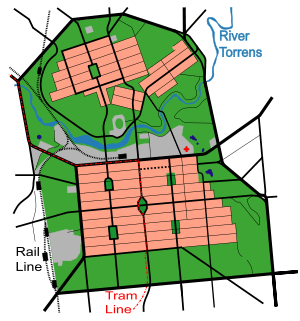
Adelaide is separated from its greater metropolitan area by a ring of public parklands on all sides. The so-called "square mile" within the park lands is defined by a small area of high rise office and apartment buildings in the centre north, around King William Street, which runs north-to-south through the centre. Surrounding this central business district are a large number of medium to low density apartments, townhouses and detached houses which make up the residential portion of the city centre.
Layout
The layout of Adelaide, known as Light's Vision, features a cardinal direction grid pattern of wide streets and terraces and five large public squares: Victoria Square in the centre of the city, and Hindmarsh, Light, Hurtle and Whitmore Squares in the centres of each of the four quadrants of the Adelaide city centre. These squares occupy 32 of the 700 numbered "town acre" allotments on Light's plan.
All east-west roads change their names as they cross King William Street, except for North and South terraces.[5] They also alternate between being wide and narrow, 99 and 66 feet (30 and 20 m), except for the central Grote and Wakefield which are extra-wide, 132 feet (40 m),[6] along with the surrounding four terraces.[7] In the south half of the city, in several places the Adelaide City Council has constructed wide footpaths and road markings to restrict traffic to a lesser number of lanes than the full width of the road could support.
The street pairs, design widths, and town acres in Light's Vision are illustrated in this diagram:
| W e s t T e r r a c e |
North Terrace | E a s t T c e |
132 ft | ||||||||||||||||||||||||||||||||||||||||||||
| 1 | 2 | 3 | 4 | 5 | 6 | 7 | 8 | M o r |
9 | 10 | 11 | 12 | 13 | 14 | 15 | 16 | K i n g |
17 | 18 | 19 | 20 | 21 | 22 | 23 | 24 | P u l |
25 | 26 | 27 | 28 | 29 | 30 | 31 | ||||||||||||||
| 62 | 61 | 60 | 59 | 58 | 57 | 56 | 55 | 54 | 53 | 52 | 51 | 50 | 49 | 48 | 47 | 46 | 45 | 44 | 43 | 42 | 41 | 40 | 39 | 38 | 37 | 36 | 35 | 34 | 33 | 32 | |||||||||||||||||
| Hindley | Street | Rundle | Street | 66 ft | |||||||||||||||||||||||||||||||||||||||||||
| 63 | 64 | 65 | 66 | 67 | 68 | 69 | 70 | 71 | 72 | 73 | 74 | 75 | 76 | 77 | 78 | 79 | 80 | 81 | 82 | 83 | 84 | 85 | 86 | 87 | 88 | 89 | 90 | 91 | 92 | 93 | |||||||||||||||||
| 124 | 123 | 122 | 121 | 120 | 119 | 118 | Light Square |
115 | 114 | 113 | 112 | 111 | 110 | 109 | 108 | 107 | 106 | 105 | 104 | 103 | 102 | Hind- marsh Square |
99 | 98 | 97 | 96 | 95 | 94 | |||||||||||||||||||
| Currie | Street | Grenfell | Street | 99 ft | |||||||||||||||||||||||||||||||||||||||||||
| 125 | 126 | 127 | 128 | 129 | 130 | 131 | 134 | 135 | 136 | 137 | 138 | 139 | 140 | 141 | 142 | 143 | 144 | 145 | 146 | 147 | 150 | 151 | 152 | 153 | 154 | 155 | |||||||||||||||||||||
| 186 | 185 | 184 | 183 | 182 | 181 | 180 | 177 | 176 | 175 | 174 | 173 | 172 | 171 | 170 | 169 | 168 | 167 | 166 | 165 | 164 | 161 | 160 | 159 | 158 | 157 | 156 | |||||||||||||||||||||
| Waymouth | p h e t t |
Street | Pirie | t e n e y |
Street | 66 ft | |||||||||||||||||||||||||||||||||||||||||
| 187 | 188 | 189 | 190 | 191 | 192 | 193 | 194 | 195 | 196 | 197 | 198 | 199 | 200 | 201 | 202 | 203 | 204 | 205 | 206 | 207 | 208 | 209 | 210 | 211 | 212 | 213 | 214 | 215 | 216 | 217 | 218 | H u t t S t r e e t |
219 | ||||||||||||||
| 252 | 251 | 250 | 249 | 248 | 247 | 246 | 245 | 244 | 243 | 242 | 241 | 240 | 239 | 238 | 237 | 236 | 235 | 234 | 233 | 232 | 231 | 230 | 229 | 228 | 227 | 226 | 225 | 224 | 223 | 222 | 221 | 220 | |||||||||||||||
| Franklin | Street | Flinders | Street | 99 ft | |||||||||||||||||||||||||||||||||||||||||||
| 253 | 254 | 255 | 256 | 257 | 258 | 259 | 260 | 261 | 262 | 263 | 264 | 265 | 266 | 267 | Victoria Square |
270 | 271 | 272 | 273 | 274 | 275 | 276 | 277 | 278 | 279 | 280 | 281 | 282 | 283 | 284 | 285 | 286 | |||||||||||||||
| 320 | 319 | 318 | 317 | 316 | 315 | 314 | 313 | 312 | 311 | 310 | 309 | 308 | 307 | 306 | 303 | 302 | 301 | 300 | 299 | 298 | 297 | 296 | 295 | 294 | 293 | 292 | 291 | 290 | 289 | 288 | 287 | ||||||||||||||||
| Grote Street | Wakefield Street | 132 ft | |||||||||||||||||||||||||||||||||||||||||||||
| 321 | 322 | 323 | 324 | 325 | 326 | 327 | 328 | B r o w n |
329 | 330 | 331 | 332 | 333 | 334 | 335 | 338 | 339 | 340 | 341 | 342 | 343 | 344 | H a n s o n |
345 | 346 | 347 | 348 | 349 | 350 | 351 | 352 | 353 | 354 | 355 | 356 | ||||||||||||
| 392 | 391 | 390 | 389 | 388 | 387 | 386 | 385 | 384 | 383 | 382 | 381 | 380 | 379 | 378 | 375 | 374 | 373 | 372 | 371 | 370 | 369 | 368 | 367 | 366 | 365 | 364 | 363 | 362 | 361 | 360 | 359 | 358 | 357 | ||||||||||||||
| Gouger | Street | W i l l i a m S t |
Angas | Street | E a s t |
99 ft | |||||||||||||||||||||||||||||||||||||||||
| 393 | 394 | 395 | 396 | 397 | 398 | 399 | 400 | 401 | 402 | 403 | 404 | 405 | 406 | 407 | 408 | 409 | 410 | 411 | 412 | 413 | 414 | 415 | 416 | 417 | 418 | 419 | 420 | 421 | 422 | 423 | 424 | 425 | 426 | 427 | 428 | 429 | 430 | ||||||||||
| 468 | 467 | 466 | 465 | 464 | 463 | 462 | 461 | 460 | 459 | 458 | 457 | 456 | 455 | 454 | 453 | 452 | 451 | 450 | 449 | 448 | 447 | 446 | 445 | 444 | 443 | 442 | 441 | 440 | 439 | 438 | 437 | 436 | 435 | 434 | 433 | 432 | 431 | ||||||||||
| Wright | Street | Carrington | Street | 66 ft | |||||||||||||||||||||||||||||||||||||||||||
| 469 | 470 | 471 | 472 | 473 | 474 | 475 | Whit- more Square |
478 | 479 | 480 | 481 | 482 | 483 | 484 | 485 | 486 | 487 | 488 | 489 | 490 | 491 | Hurtle Square |
494 | 495 | 496 | 497 | 498 | 499 | 500 | 501 | 502 | 503 | 504 | 505 | 506 | ||||||||||||
| 544 | 543 | 542 | 541 | 540 | 539 | 538 | 535 | 534 | 533 | 532 | 531 | 530 | 529 | 528 | 527 | 526 | 525 | 524 | 523 | 522 | 519 | 518 | 517 | 516 | 515 | 514 | 513 | 512 | 511 | 510 | 509 | 508 | 507 | ||||||||||||||
| Sturt | Street | Halifax | Street | T c e |
99 ft | ||||||||||||||||||||||||||||||||||||||||||
| 545 | 546 | 547 | 548 | 549 | 550 | 551 | 554 | 555 | 556 | 557 | 558 | 559 | 560 | 561 | 562 | 563 | 564 | 565 | 566 | 567 | 570 | 571 | 572 | 573 | 574 | 575 | 576 | 577 | 578 | 579 | 580 | 581 | 582 | 583 | |||||||||||||
| 622 | 621 | 620 | 619 | 618 | 617 | 616 | 615 | S t |
614 | 613 | 612 | 611 | 610 | 609 | 608 | 607 | 606 | 605 | 604 | 603 | 602 | 601 | 600 | 599 | S t |
598 | 597 | 596 | 595 | 594 | 593 | 592 | 591 | 590 | 589 | 588 | 587 | 586 | 585 | 584 | |||||||
| Gilbert | Street | Gilles | Street | 66 ft | |||||||||||||||||||||||||||||||||||||||||||
| 623 | 624 | 625 | 626 | 627 | 628 | 629 | 630 | 631 | 632 | 633 | 634 | 635 | 636 | 637 | 638 | 639 | 640 | 641 | 642 | 643 | 644 | 645 | 646 | 647 | 648 | 649 | 650 | 651 | 652 | 653 | 654 | 655 | 656 | 657 | 658 | 659 | 660 | 661 | |||||||||
| 700 | 699 | 698 | 697 | 696 | 695 | 694 | 693 | 692 | 691 | 690 | 689 | 688 | 687 | 686 | 685 | 684 | 683 | 682 | 681 | 680 | 679 | 678 | 677 | 676 | 675 | 674 | 673 | 672 | 671 | 670 | 669 | 668 | 667 | 666 | 665 | 664 | 663 | 662 | |||||||||
| South Terrace | 132 ft | ||||||||||||||||||||||||||||||||||||||||||||||
| 132 ft | 99 ft | 132 ft | 99 ft | 132 ft | 132 ft | (width) | |||||||||||||||||||||||||||||||||||||||||
Street and square names
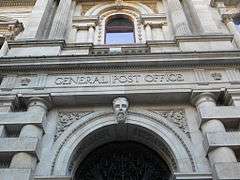
The streets and squares were named by a committee of a number of prominent settlers after themselves, after early directors of the South Australian Company, after Colonisation Commissioners of South Australia (appointed by the British government to oversee implementation of the acts that established the colony), and after various notables involved in the establishment of the colony.
The Street Naming Committee comprised:[8]
|
|
All members of the committee (except Stephens) had one or more of the streets and squares in the Adelaide city centre and North Adelaide named after themselves. Brown Street, named for John Brown, was subsequently subsumed as a continuation of Morphett Street in 1967. In the same year, Hanson Street, named for Richard Hanson, was subsumed as a continuation of Pulteney Street.
The squares were named after:
- Victoria - the regent, Princess Victoria, later Queen Victoria
- Hindmarsh - Rear Admiral Sir John Hindmarsh, first Governor of South Australia
- Hurtle - Sir James Hurtle Fisher, first Resident Commissioner
- Light - Colonel William Light, Surveor General
- Whitmore - William Wolryche-Whitmore MP, a Colonial Commissioner in London
The east-west streets named on 22 December 1836 were:[11]
- Rundle – John Rundle MP, Director of the South Australian Company
- Hindley – Charles Hindley MP, Director of South Australian Company
- Grenfell – Pascoe St Leger Grenfell MP, presented town acre for Holy Trinity Church and other country lands
- Currie – Raikes Currie MP, Director of South Australian Company
- Pirie – Sir John Pirie, alderman and later Lord Mayor of London, Director of South Australian Company
- Waymouth – Henry Waymouth, Director South Australian Company
- Flinders – Matthew Flinders, explorer
- Franklin – Rear Admiral Sir John Franklin, midshipman under Flinders
- Wakefield – Daniel Bell Wakefield, barrister who drafted the South Australia Act[12]
- Grote – George Grote MP, treasurer of the South Australia Association
- Angas – George Fife Angas, a Colonial Commissioner and founding Chairman of Directors of the South Australian Company
- Gouger – Robert Gouger, first Colonial Secretary
Most of these people did not reside in or visit South Australia.
The naming of the streets was completed on 23 May 1837[8] and gazetted on 3 June.[13]
East-west streets:
- Carrington - John Abel Smith (Lord Carrington)
- Wright - John Wright, Colonial Commissioner and financier[14]
- Halifax - Charles Wood, 1st Viscount Halifax, Chancellor of the Exchequer
- Sturt - Charles Sturt, explorer
- Gilles - Osmond Gilles, early treasurer of the colony
- Gilbert - Thomas Gilbert, storekeeper and postmaster[14]
North-south streets:
- Morphett - John Morphett, member of the South Australian parliament
- Pulteney - Admiral Sir Pulteney Malcolm, British naval officer
- Hutt - William Hutt MP, a Colonial Commissioner
Dual naming of squares and parklands
The Adelaide City Council began the process of dual naming all of the city squares, each of the parks making up the parklands which surround the city centre and North Adelaide, and other sites of significance to the Kaurna people in 1997.[15] The naming process, which assigned an extra name in the Kaurna language to each place, was mostly completed in 2003,[16] and the renaming of 39 sites finalised and endorsed by the council in 2012.[17]
- Victoria Square - Tarntanyangga ('red kangaroo dreaming')
- Hindmarsh Square - Mukata
- Hurtle Square - Tangkaira
- Light Square - Wauwi
- Whitmore Square - Iparrityi
20th-21st century precincts
The City of Adelaide Council has defined a number of neighbourhood precincts in the city centre, each with a character of their own:
- The East End, centering on Rundle Street - known for its restaurants, bars, high-end fashion shops, the Palace Nova Cinema;[18]
- The West End, from the western end of North Terrace and encompassing several blocks southward, which includes UniSA "CityWest" campus, the Samstag Museum of Art, JamFactory, Lion Arts Centre, Mercury Cinema, numerous bars, clubs and restaurants, and "BioMed City";[19]
- The South East of the city, largely residential, but including many cafés, restaurants, pubs, etc.;[20] and
- The South West is very diverse; largely residential and including the Adelaide Central Market[20]
In addition to these, the north-eastern side of North Terrace is often referred to as the "North Terrace cultural precinct" or "cultural boulevard", and includes the Art Gallery of South Australia, the State Library of South Australia, the South Australian Museum, the Migration Museum, the Adelaide Botanic Garden, the University of Adelaide and the "CityEast" campus of the UniSA[21]
Demographics
Due to the construction of many new apartments in the city, the population grew over ten years from 10,229 (2006 census)[22] to 15,115 (2016 census).[1]
In the 2016 Census, there were 15,115 people in the Adelaide city centre, of whom 38.8% were born in Australia. The next most common countries of birth were China 17.5%, Malaysia 4.4%, England 3.4%, Hong Kong 2.8% and India 1.9%. 44.6% of people spoke only English at home. Other languages spoken at home included Mandarin 19.6%, Cantonese 4.9%, Arabic 1.9%, Korean 1.9% and Vietnamese 1.1%. The most common response for religion in Adelaide was 'No Religion' at 47.7% of the population.[1]
Politics
At federal level, Adelaide is within the Division of Adelaide, a marginal seat which historically has alternated between the Liberal and Labor parties. It has been held since 2004 by Kate Ellis of the Labor party.[23]
In the South Australian House of Assembly, Adelaide is within the Electoral district of Adelaide. Since the March 2010 state election, the seat has been held by Rachel Sanderson of the Liberal party.
Culture

Adelaide's cultural and entertainment precincts/venues are generally concentrated in the city centre. They include the Convention Centre, Entertainment Centre and the redeveloped Adelaide Oval. Additionally, most of the events relating to the Adelaide Festival and Adelaide Fringe are held within Adelaide's city centre during February and March. This time is known as "Mad March", due to the large number of other cultural festivities at the same time, including the Adelaide 500 and WOMADelaide. North Terrace is considered Adelaide's "cultural boulevard" because of its tight concentration of galleries and museums.
Gallery
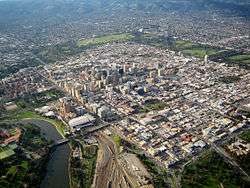 Aerial view of the Adelaide city centre looking south-east, 2005.
Aerial view of the Adelaide city centre looking south-east, 2005.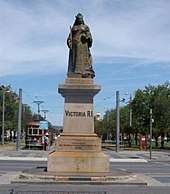 A statue of Queen Victoria has stood in the geometric centre of both Victoria Square and "the square mile" since 1894.
A statue of Queen Victoria has stood in the geometric centre of both Victoria Square and "the square mile" since 1894. Part of North Terrace, 2009.
Part of North Terrace, 2009. Adelaide CBD from above, 2010.
Adelaide CBD from above, 2010. High rise buildings on Hindmarsh Square, 2012.
High rise buildings on Hindmarsh Square, 2012. Statue of King Edward VII on North Terrace.
Statue of King Edward VII on North Terrace. St Francis Xavier's Cathedral, Victoria Square.
St Francis Xavier's Cathedral, Victoria Square.

- From the North
 East Tce to King Wm St, 2012
East Tce to King Wm St, 2012 King Wm St to Morphett St, 2012
King Wm St to Morphett St, 2012 from Light's Vision, 1997
from Light's Vision, 1997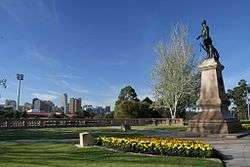 Light's Vision, 2006
Light's Vision, 2006 from Light's Vision, 2008
from Light's Vision, 2008 from Light's Vision, 2008
from Light's Vision, 2008- from Light's Vision, 2008
 from Lightsview, 2008
from Lightsview, 2008 "from the North", 2014
"from the North", 2014
- From the East
 from Mount Lofty, 2005
from Mount Lofty, 2005- from Waterfall Gully, 2005
 from Mount Lofty, 2007
from Mount Lofty, 2007 from Mount Lofty, 2007
from Mount Lofty, 2007 from Mount Lofty, 2007
from Mount Lofty, 2007 from Mount Lofty, 2014
from Mount Lofty, 2014
- From the South (West -> East)
 from Flinders University, 2006
from Flinders University, 2006 from circa Panorama, Christmas 2005
from circa Panorama, Christmas 2005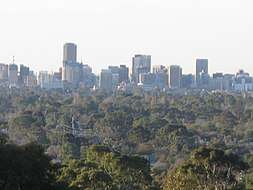 from Sleeps Hill, 2008
from Sleeps Hill, 2008 from Carrick Hill, 2008
from Carrick Hill, 2008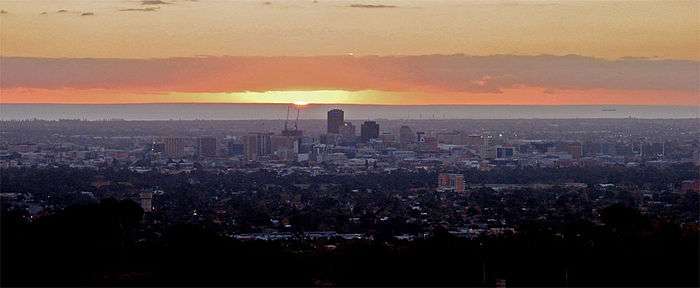 from circa Glen Osmond, 2006
from circa Glen Osmond, 2006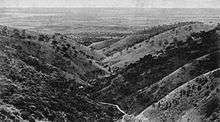 from Eagle on the Hill, 1910
from Eagle on the Hill, 1910
- From the West
 from Hindmarsh Stadium, 2007
from Hindmarsh Stadium, 2007 from Adelaide Airport, 2014
from Adelaide Airport, 2014
See also
- Adelaide (Greater Adelaide metropolis)
- City of Adelaide (local government area)
- North Adelaide
- Street art in Adelaide
- Grid layout
Notes
- Australian Bureau of Statistics (27 June 2017). "Adelaide (State Suburb)". 2016 Census QuickStats. Retrieved 23 November 2017.

- Australian Bureau of Statistics (31 October 2012). "Adelaide (State Suburb)". 2011 Census QuickStats. Retrieved 25 January 2015.

- "Eastern Adelaide SA Government region" (PDF). The Government of South Australia. Retrieved 17 April 2017.
- "Tarndanya", KauranaPlaceNames.com. Retrieved 2009-09-09.
- Royal Automobile Association. "Adelaide CBD & North Adelaide" (PDF). Retrieved 7 December 2014. This map, showing the Adelaide city centre, North Adelaide and the Adelaide Parklands, was published on the website "soul underground".
- Elgar, Frederic (1863). Handbook to the Colony of South Australia. London: "Australian and New Zealand Gazette" Office. p. 3. Retrieved 8 December 2014.
... principal north and south streets (from 99 to 132 feet wide) being nearly one mile in length, and the east and west streets (from 66 to 132 feet wide) from a mile and a quarter to a mile and three quarters.
- Margaret Anderson (31 December 2013). "Light's Plan of Adelaide 1837". adelaidia.sa.gov.au. History SA. Retrieved 5 May 2018.
The page contains a copy of one of the two surviving original plans drawn in 1837. Quote: "It is a watercolour and ink plan, drawn by 16-year-old draughtsman Robert George Thomas to instructions from Light. ... The streets were named by a Street Naming Committee that met on 23 May 1837, indicating that this plan must have been completed after that date." - "The Street Naming Committee". HistorySouthAustralia.net. 30 September 2001. Retrieved 22 September 2011.
- The Colonial Storekeeper, like the Colonial Secretary, was an official position.
- "Stephens, Edward (1811-1861)". Australian Dictionary of Biography. Melbourne University Press. 1967. ISSN 1833-7538. Retrieved 22 September 2011 – via National Centre of Biography, Australian National University.
- "City Streets named 22 December 1836". SAHistorians.org.au.
- Daniel Bell Wakefield should not to be confused with his uncle, Daniel Wakefield. Note that the street is named after him, not after his better known brother Edward Gibbon Wakefield - Refer Wakefield Street Archived 23 July 2011 at the Wayback Machine in "Streets Named on the 23rd May, 1837", HistorySouthAustralia.net.
- "City of Adelaide municipal year book". Adelaide: Adelaide City Council. 1972: 57, 70. Cite journal requires
|journal=(help) - Spence & Beams (2006) p.33
- Adelaide City Council. "Adelaide City Council Placenaming Initiatives". Kaurna Warra Pintyanthi. University of Adelaide. Retrieved 28 November 2019.
- Adelaide City Council. "Kaurna Placename Meanings within the City of Adelaide". Kaurna Warra Pintyanthi. University of Adelaide. Retrieved 28 November 2019.
- "Kaurna place naming: Recognising Kaurna heritage through physical features of the city". City of Adelaide. Retrieved 29 November 2019.
- "East End". City of Adelaide. Retrieved 30 July 2019.
- "West End". City of Adelaide. Retrieved 30 July 2019.
- "City neighbourhoods". City of Adelaide. Retrieved 8 August 2019.
- "North Terrace cultural precinct". Adelaidia. Retrieved 30 July 2019.
- Australian Bureau of Statistics (25 October 2007). "Adelaide (State Suburb)". 2006 Census QuickStats. Retrieved 23 November 2017.
- Antony Green (27 December 2007). "Adelaide (Inner City) - Green Guide". ABC News Online - Elections. Australian Broadcasting Corporation. Retrieved 3 January 2009.
References
- Spence, Catherine Helen; Beams, Maryan (2006). Susan Magarey; Barbara Wall; Maryan Beams; Mary Lyons (eds.). Ever yours, C.H. Spence: Catherine Helen Spence's An autobiography (1825-1910), Diary (1894) and Some correspondence (1894-1910). Wakefield Press. ISBN 978-1-86254-656-1.
Further reading
- "Nomenclature of the Streets of Adelaide and North Adelaide" (PDF). State Library of South Australia.
taken from The City of Adelaide Year Book, 1939-1940
Cite journal requires|journal=(help) - Nicholas, Jeff; Grenvell, Julian, Lord, Baron of Kilvey, (writer of foreword.) (2016), Behind the streets of Adelaide : the unrevealed history of the roads and pavements of a modern city (Limited edition hardback set ed.), Torrens Press, ISBN 978-0-9945330-0-5CS1 maint: multiple names: authors list (link)